Synthesis, Characterization and Biological Investigation of New N-Modified Spinorphin Analogs
Abstract
1. Introduction
2. Results and Discussion
2.1. Chemistry
2.2. Physicochemical Characterization
2.2.1. Determination of Partition Coefficient
2.2.2. Determination of Acid-Base Constant (pKa) and Isoelectric Point (pI) by Spectral Methods
2.2.3. Voltamperometric Characterization
2.3. Biological Analysis
2.3.1. Anticonvulsant Activity
Six Hz Test for Psychomotor Seizures
Maximal Electroshock Test
Intravenous Pentylenetetrazole Seizure (ivPTZ) Test
2.3.2. Antibacterial Activity Test of Rh-S, Rh-S5, and Rh-S6
2.3.3. Antifungal Activity Test
2.3.4. Antioxidant Activity
3. Materials and Methods
3.1. Synthesis
General Procedure for the Peptide Synthesis of Compounds (Rh-S, Rh-S5, Rh-S6)
3.2. Analytical Characterizations
3.2.1. Determination of Partition Coefficient
3.2.2. Voltamperometric Analysis
3.2.3. pK and pI Determination
3.3. Pharmacology In Vivo Experiments
3.3.1. Animals
3.3.2. Drugs and Treatment
3.3.3. Tests for Anticonvulsant Activity
Six Hz Psychomotor Seizure Test
Maximal Electroshock Test (MES Test)
Intravenous Pentylenetetrazole Seizure (ivPTZ) Test
Test for Neurotoxicity Rotarod Test
3.4. Statistics
3.5. Test for Antibacterial Activity
3.6. Antifungal Activity Test
3.7. Antioxidant Activity
4. Conclusions
Author Contributions
Funding
Institutional Review Board Statement
Informed Consent Statement
Data Availability Statement
Conflicts of Interest
References
- Liang, T.S.; Gao, J.L.; Fatemi, O.; Lavigne, M.; Leto, T.L.; Murphy, P.M. The endogenous opioid spinorphin blocks fMet-Leu-Phe-induced neutrophil chemotaxis by acting as a specific antagonist at the N-formylpeptide receptor subtype FPR. J. Immunol. 2001, 167, 6609–6614. [Google Scholar] [CrossRef] [PubMed]
- Nishimura, K.; Hazato, T. Spinorphin, a new inhibitor of enkephalin-degrading enzymes derived from the bovine spinal cord. Masui 1993, 42, 1497–1503. [Google Scholar] [PubMed]
- Nishimura, K.; Hazato, T. Isolation and identification of an endogenous inhibitor of enkephalin-degrading enzymes from bovine spinal cord. Biochem. Biophys. Res. Commun. 1993, 194, 713–719. [Google Scholar] [CrossRef] [PubMed]
- Ueda, H.; Matsunaga, S.; Inoue, M.; Yamamoto, Y.; Hazato, T. Complete inhibition of purinoceptor agonist-induced nociception by spinorphin, but not by morphine. Peptides 2000, 21, 1215–1221. [Google Scholar] [CrossRef]
- Yamamoto, Y.; Ono, H.; Ueda, A.; Shimamura, M.; Nishimura, K.; Hazato, T. Spinorphin as an endogenous inhibitor of enkephalin-degrading enzymes: Roles in pain and inflammation. Curr. Protein Pept. Sci. 2002, 3, 587–599. [Google Scholar] [CrossRef] [PubMed]
- Honda, M.; Okutsu, H.; Matsuura, T.; Miyagi, T.; Yamamoto, Y.; Hazato, T.; Ono, H. Spinorphin, an endogenous inhibitor of enkephalin-degrading enzymes, potentiates leu-enkephalin-induced anti-allodynic and antinociceptive effects in mice. Jpn. J. Pharmacol. 2001, 87, 261–267. [Google Scholar] [CrossRef] [PubMed]
- Beija, M.; Afonso, C.A.; Martinho, J.M. Synthesis and applications of Rhodamine derivatives as fluorescent probes. Chem. Soc. Rev. 2009, 38, 2410–2433. [Google Scholar] [CrossRef]
- Birtalan, E.; Rudat, B.; Kölmel, D.K.; Fritz, D.; Vollrath, S.B.; Schepers, U.; Bräse, S. Investigating rhodamine B-labeled peptoids: Scopes and limitations of its applications. Pept. Sci. 2011, 96, 694–701. [Google Scholar] [CrossRef]
- Li, M.; Yuan, L.; Chen, Y.; Ma, W.; Ran, F.; Zhang, L.; Xiao, S. Rhodamine B-based fluorescent probes for molecular mechanism study of the anti-influenza activity of pentacyclic triterpenes. Eur. J. Med. Chem. 2020, 205, 112664. [Google Scholar] [CrossRef]
- Lavis, L.D.; Raines, R.T. Bright ideas for chemical biology. ACS Chem. Biol. 2008, 3, 142–155. [Google Scholar] [CrossRef]
- HwanáKwak, J.; JuáKang, E.; HoáLee, B.; ChoonáYoo, Y.; BokáLee, K.; SeungáKim, J. Synthesis of rhodamine-labelled dieckol: Its unique intracellular localization and potent anti-inflammatory activity. Chem. Commun. 2014, 50, 13045–13048. [Google Scholar]
- Todorov, P.; Peneva, P.; Georgieva, S.; Tchekalarova, J.; Rangelov, M.; Todorova, N. Synthesis and characterization of new 5,5′-dimethyl-and 5,5′-diphenylhydantoin-conjugated hemorphin derivatives designed as potential anticonvulsant agents. New J. Chem. 2022, 46, 2198–2217. [Google Scholar] [CrossRef]
- Todorov, P.; Georgieva, S.; Peneva, P.; Tchekalarova, J. Investigation of the structure–activity relationship in a series of new LVV-and VV-hemorphin-7 analogues designed as potential anticonvulsant agents. Amino Acids 2022, 54, 261–275. [Google Scholar] [CrossRef] [PubMed]
- Assenov, B.; Pechlivanova, D.; Dzhambazova, E.; Peneva, P.; Todorov, P. Antinociceptive effects of VV-hemorphin-5 peptide analogues containing amino phosphonate moiety in mouse formalin model of pain. Protein Pept. Lett. 2021, 28, 442–449. [Google Scholar] [CrossRef] [PubMed]
- Mielczarek, P.; Hartman, K.; Drabik, A.; Hung, H.Y.; Huang, E.Y.K.; Gibula-Tarlowska, E.; Kotlinska, J.H.; Silberring, J. Hemorphins—From discovery to functions and pharmacology. Molecules 2021, 26, 3879. [Google Scholar] [CrossRef]
- Lau, J.L.; Dunn, M.K. Therapeutic peptides: Historical perspectives, current development trends, and future directions. Bioorg. Med. Chem. 2018, 26, 2700–2707. [Google Scholar] [CrossRef] [PubMed]
- Ayoub, M.A.; Vijayan, R. Hemorphins targeting g protein-coupled receptors. Pharmaceuticals 2021, 14, 225. [Google Scholar] [CrossRef] [PubMed]
- Stevenazzi, A.; Marchini, M.; Sandrone, G.; Vergani, B.; Lattanzio, M. Amino acidic scaffolds bearing unnatural side chains: An old idea generates new and versatile tools for the life sciences. Bioorg. Med. Chem. Lett. 2014, 24, 5349–5356. [Google Scholar] [CrossRef]
- Prasad, S.; Rao, R.B.; Balaram, P. Contrasting solution conformations of peptides containing α, α-dialkylated residues with linear and cyclic side chains. Biopolym. Orig. Res. Biomol. 1995, 35, 11–20. [Google Scholar] [CrossRef] [PubMed]
- Blishchenko, E.Y.; Sazonova, O.V.; Kalinina, O.A.; Yatskin, O.N.; Philippova, M.M.; Surovoy, A.Y.; Karelin, A.A.; Ivanov, V.T. Family of hemorphins: Co-relations between amino acid sequences and effects in cell cultures. Peptides 2002, 23, 903–910. [Google Scholar] [CrossRef]
- Mortensen, U.H.; Raaschou-Nielsen, M.; Breddam, K. Recognition of C-terminal amide groups by (serine) carboxypeptidase Y investigated by site-directed mutagenesis. J. Biol. Chem. 1994, 269, 15528–15532. [Google Scholar] [CrossRef]
- Pogozheva, I.D.; Przydzial, M.J.; Mosberg, H.I. Homology modeling of opioid receptor-ligand complexes using experimental constraints. AAPS J. 2005, 7, E434–E448. [Google Scholar] [CrossRef] [PubMed]
- Moisan, S.; Harvey, N.; Beaudry, G.; Forzani, P.; Burhop, K.E.; Drapeau, G.; Rioux, F. Structural requirements and mechanism of the pressor activity of Leu-Val-Val-hemorphin-7, a fragment of hemoglobin β-chain in rats. Peptides 1998, 19, 119–131. [Google Scholar] [CrossRef]
- Todorov, P.; Georgieva, S.; Staneva, D.; Peneva, P.; Grozdanov, P.; Nikolova, I.; Grabchev, I. Synthesis of New Modified with Rhodamine B Peptides for Antiviral Protection of Textile Materials. Molecules 2021, 26, 6608. [Google Scholar] [PubMed]
- Fornander, L.H.; Feng, B.; Beke-Somfai, T.; Nordén, B. UV transition moments of tyrosine. J. Phys. Chem. B 2014, 118, 9247–9257. [Google Scholar] [CrossRef] [PubMed]
- Yashchuk, V.M.; Kudrya, V.Y.; Levchenko, S.M.; Tkachuk, Z.Y.; Hovorun, D.M.; Mel’nik, V.I.; Vorob’yov, V.P.; Klishevich, G.V. Optical response of the polynucleotides-proteins interaction. Mol. Cryst. Liq. Cryst. 2011, 535, 93–110. [Google Scholar] [CrossRef]
- Hill, S.C.; Mayo, M.W.; Chang, R.K. Fluorescence of Bacteria, Pollens, and Naturally Occurring Airborne Particles: Excitation/Emission Spectra; Army Research Lab Adelphi Md Computational and Information Sciences Directorate: Adelphi, MD, USA, 2009. [Google Scholar]
- Lakowicz, J.R. (Ed.) Principles of Fluorescence Spectroscopy; Springer: Boston, MA, USA, 2006. [Google Scholar]
- Kaye, P.H.; Stanley, W.R.; Hirst, E.; Foot, E.V.; Baxter, K.L.; Barrington, S.J. Single particle multichannel bio-aerosol fluorescence sensor. Opt. Express 2005, 13, 3583–3593. [Google Scholar] [CrossRef]
- Xia, M.C.; Cai, L.; Zhang, S.; Zhang, X. Cell-penetrating peptide spirolactam derivative as a reversible fluorescent pH probe for live cell imaging. Anal. Chem. 2017, 89, 1238–1243. [Google Scholar] [CrossRef] [PubMed]
- Williams, R.T.; Bridges, J.W. Fluorescence of solutions: A review. J. Clin. Pathol. 1964, 17, 371. [Google Scholar] [CrossRef]
- Zheng, H.; Shang, G.Q.; Yang, S.Y.; Gao, X.; Xu, J.G. Fluorogenic and chromogenic rhodamine spirolactam based probe for nitric oxide by spiro ring opening reaction. Org. Lett. 2008, 10, 2357–2360. [Google Scholar] [CrossRef] [PubMed]
- Ucar, M.; Polat, K.; Solak, A.O.; Toy, M.; Aksu, M.L. The electrochemical behaviour of 2′-halogenated derivatives of 4-methoxyazobenzene at a mercury electrode. Dyes Pigm. 2010, 87, 55–61. [Google Scholar] [CrossRef]
- Zhu, X.; Wu, G.; Wang, C.; Zhang, D.; Yuan, X. A miniature and low-cost electrochemical system for sensitive determination of rhodamine B. Measurement 2018, 120, 206–212. [Google Scholar] [CrossRef]
- Swinyard, E.A.; Boson, F.C.; Goodman, L.S. Effect of epinephrine and norepinephrine on excitability of central nervous system of mice. J. Pharmacol. Exp. Ther. 1964, 144, 52–59. [Google Scholar]
- Haram, S.K.; Mahadeshwar, A.R.; Dixit, S.G. Synthesis and characterization of copper sulfide nanoparticles in Triton-X 100 water-in-oil microemulsions. J. Phys. Chem. 1996, 100, 5868–5873. [Google Scholar] [CrossRef]
- Daffy, L.M.; De Silva, A.P.; Gunaratne, H.N.; Huber, C.; Lynch, P.M.; Werner, T.; Wolfbeis, O.S. Arenedicarboximide building blocks for fluorescent photoinduced electron transfer pH sensors applicable with different media and communication wavelengths. Chem. Eur. J. 1998, 4, 1810–1815. [Google Scholar] [CrossRef]
- Todorov, P.; Rangelov, M.; Peneva, P.; Todorova, N.; Tchekalarova, J. Anticonvulsant evaluation and docking analysis of VV-Hemorphin-5 analogues. Drug Dev. Res. 2019, 80, 425–437. [Google Scholar] [CrossRef] [PubMed]
- Todorov, P.; Peneva, P.; Tchekalarova, J.; Georgieva, S.; Rangelov, M.; Todorova, N. Structure–activity relationship study on new Hemorphin-4 analogues containing steric restricted amino acids moiety for evaluation of their anticonvulsant activity. Amino Acids 2020, 52, 375–1390. [Google Scholar] [CrossRef]
- Millauskas, G.; Venskutonis, P.R.; Van Beek, T.A. Screening of radical scavenging activity of some medicinal and aromatic plant extracts. Food Chem. 2004, 85, 231–237. [Google Scholar] [CrossRef]

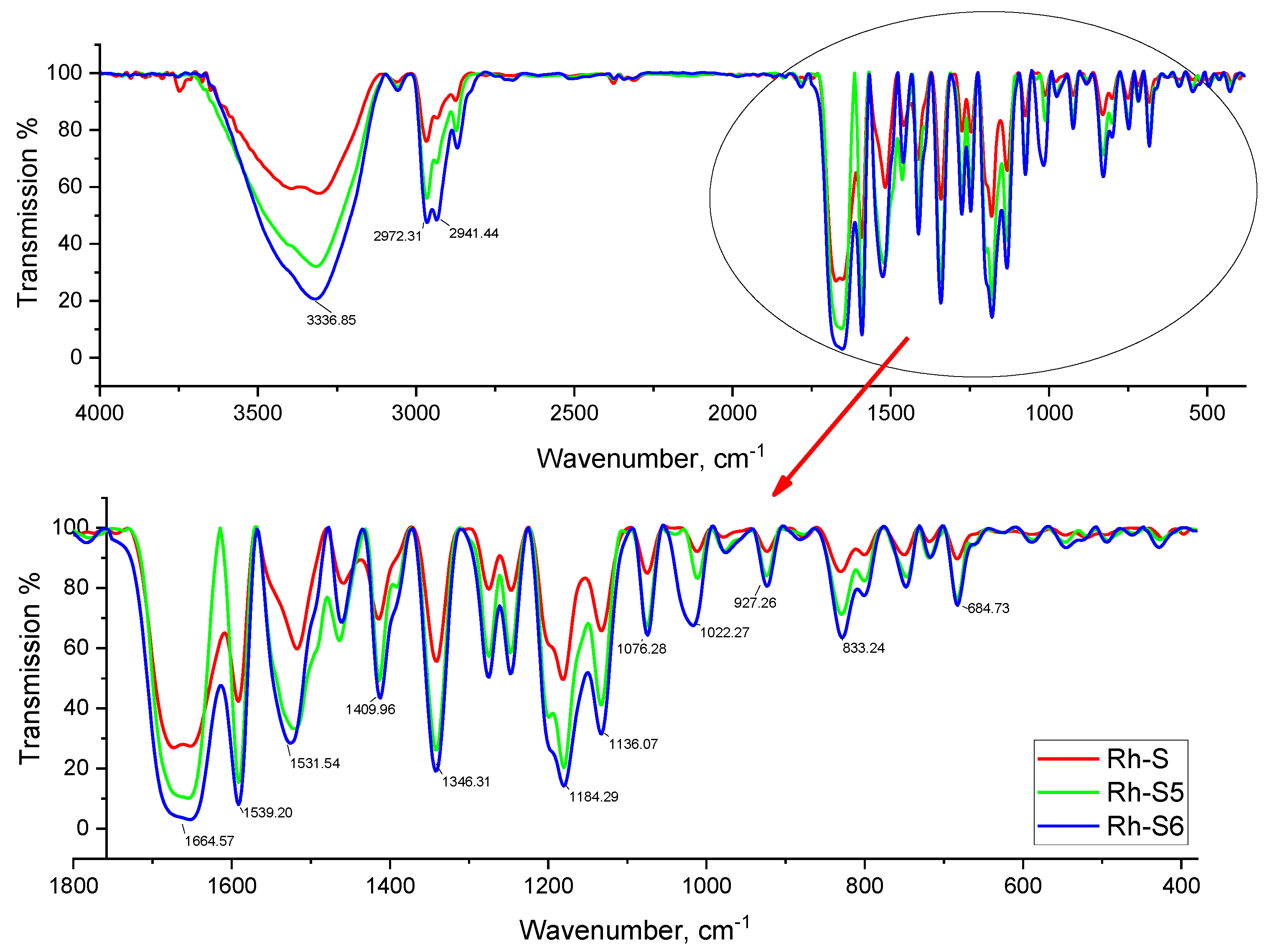

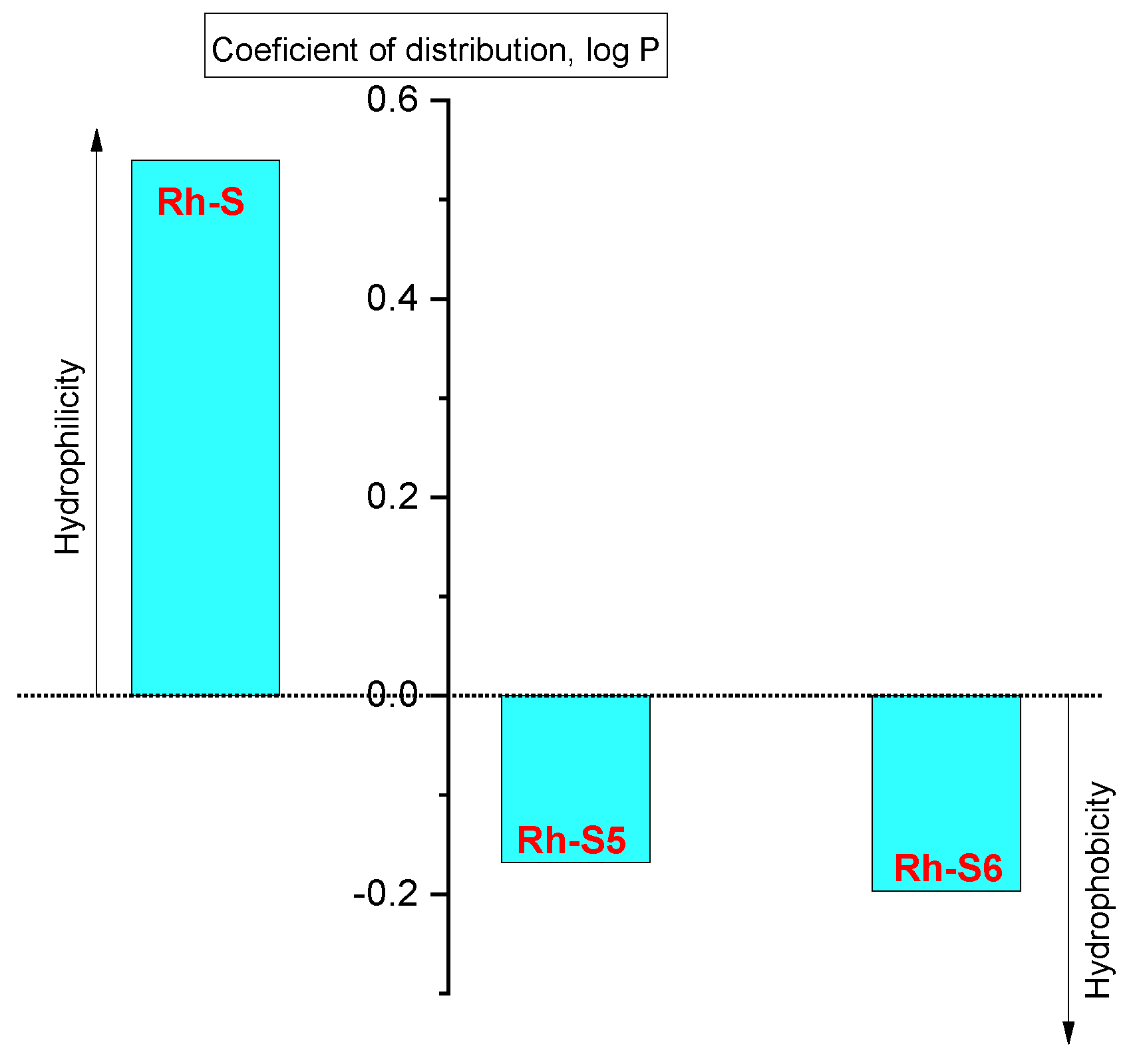
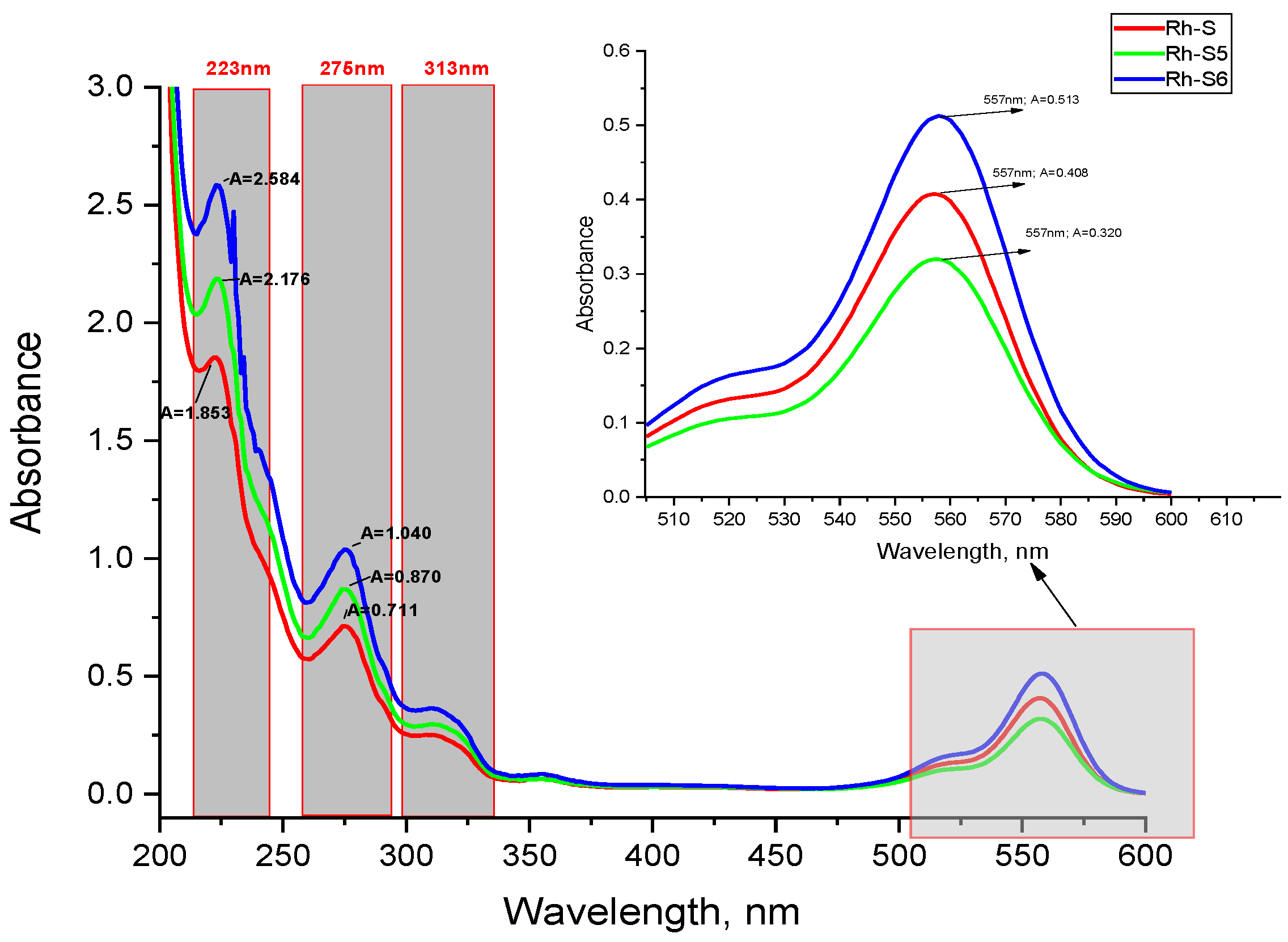
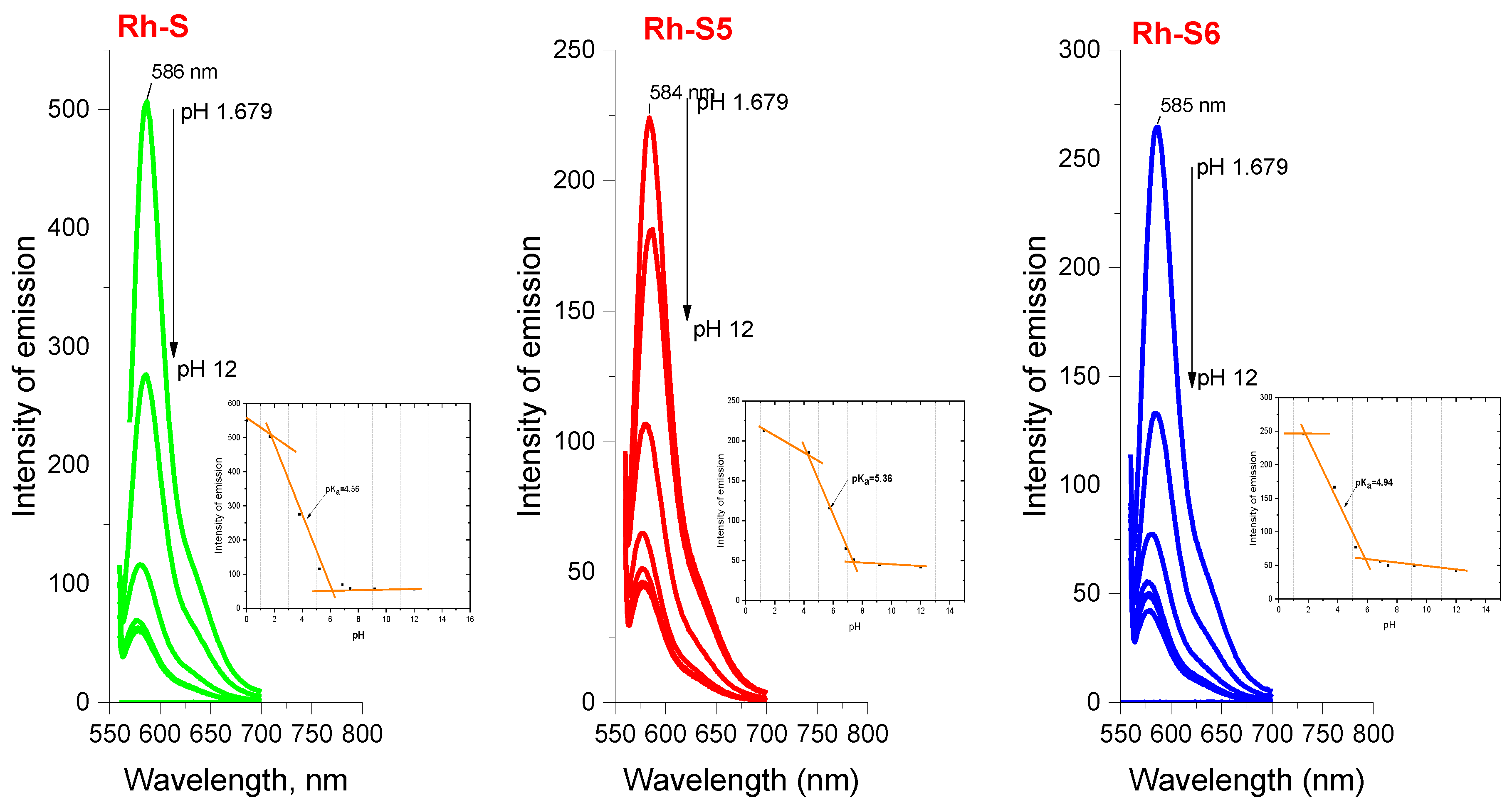
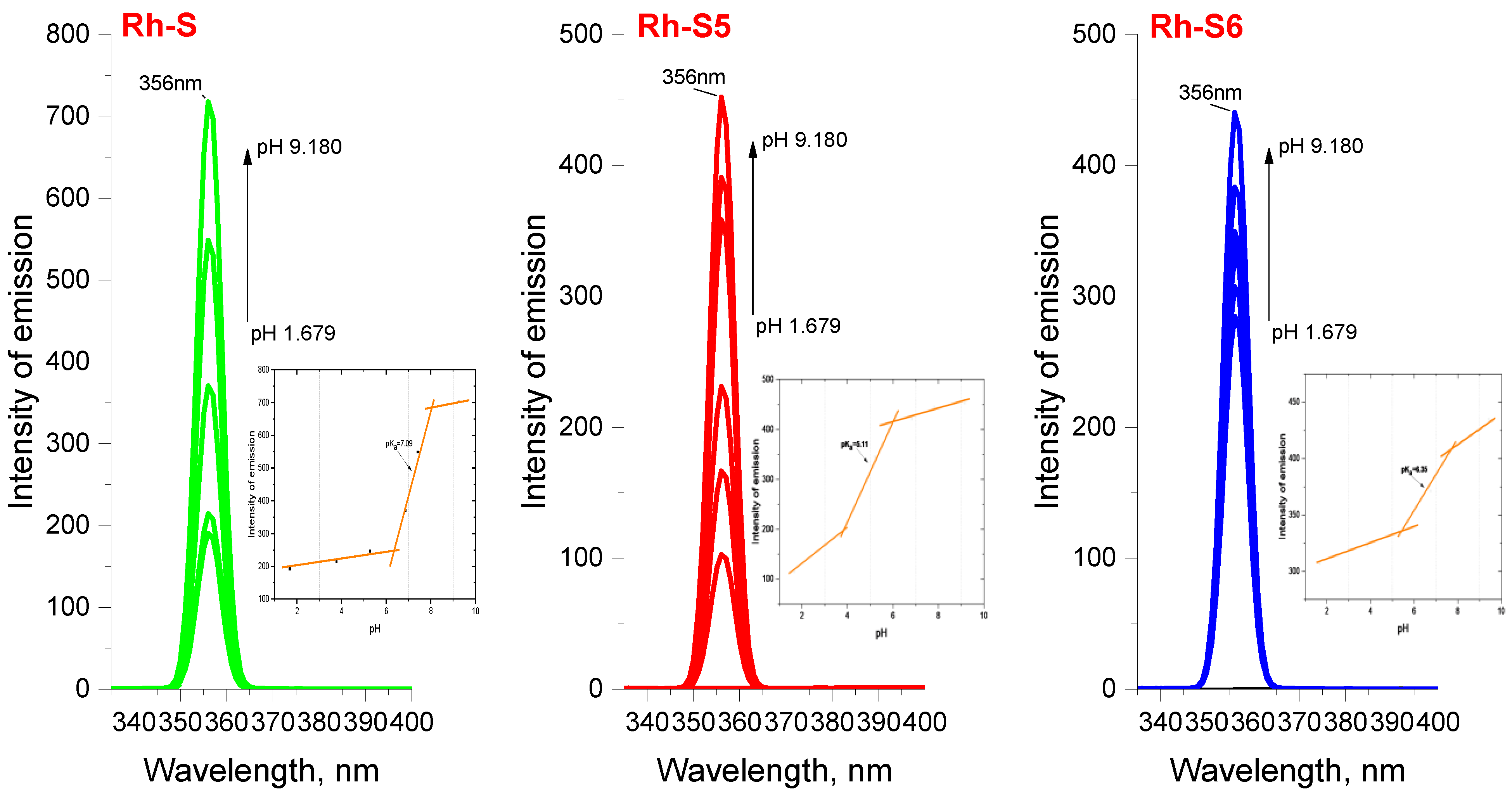
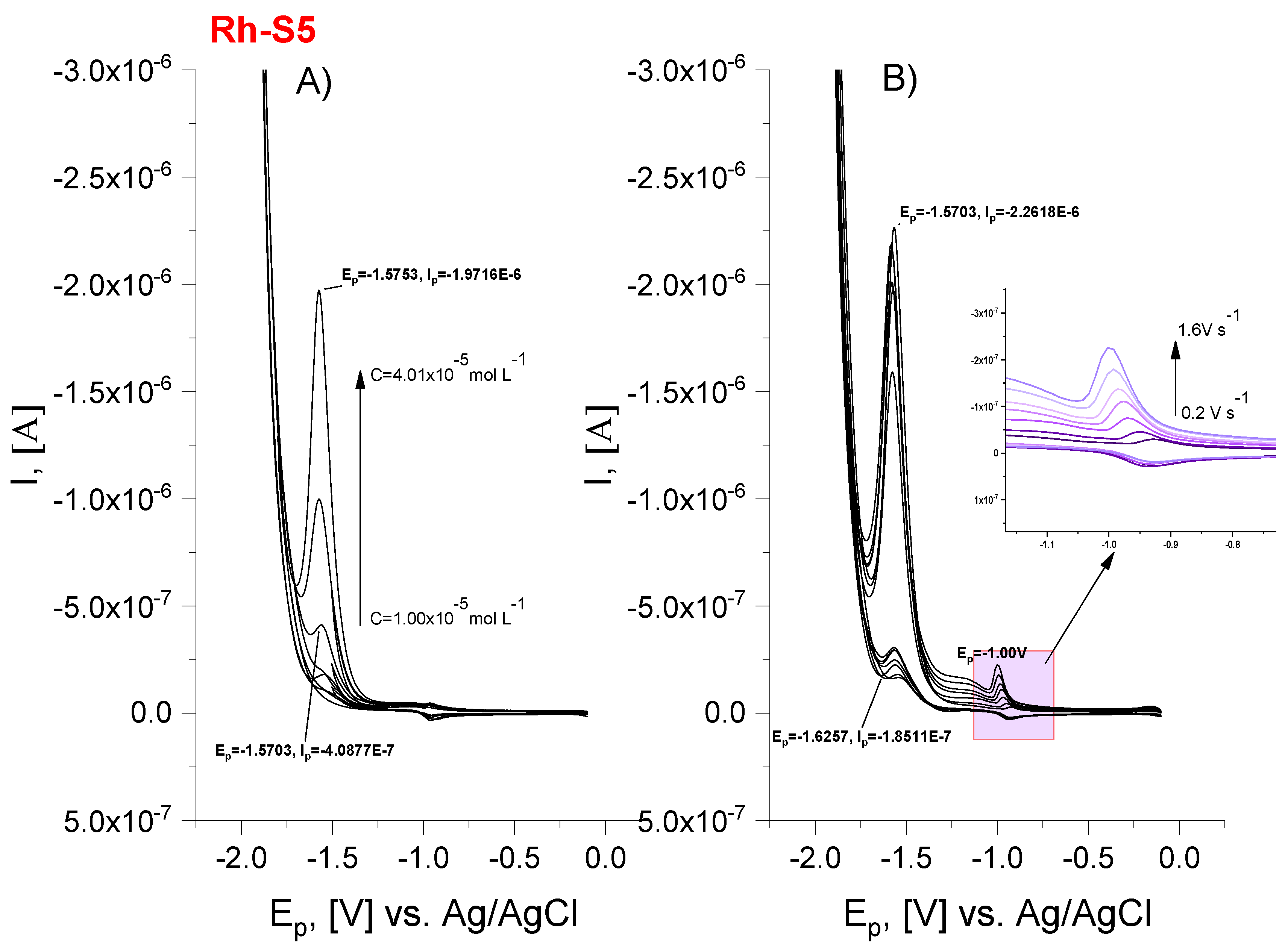
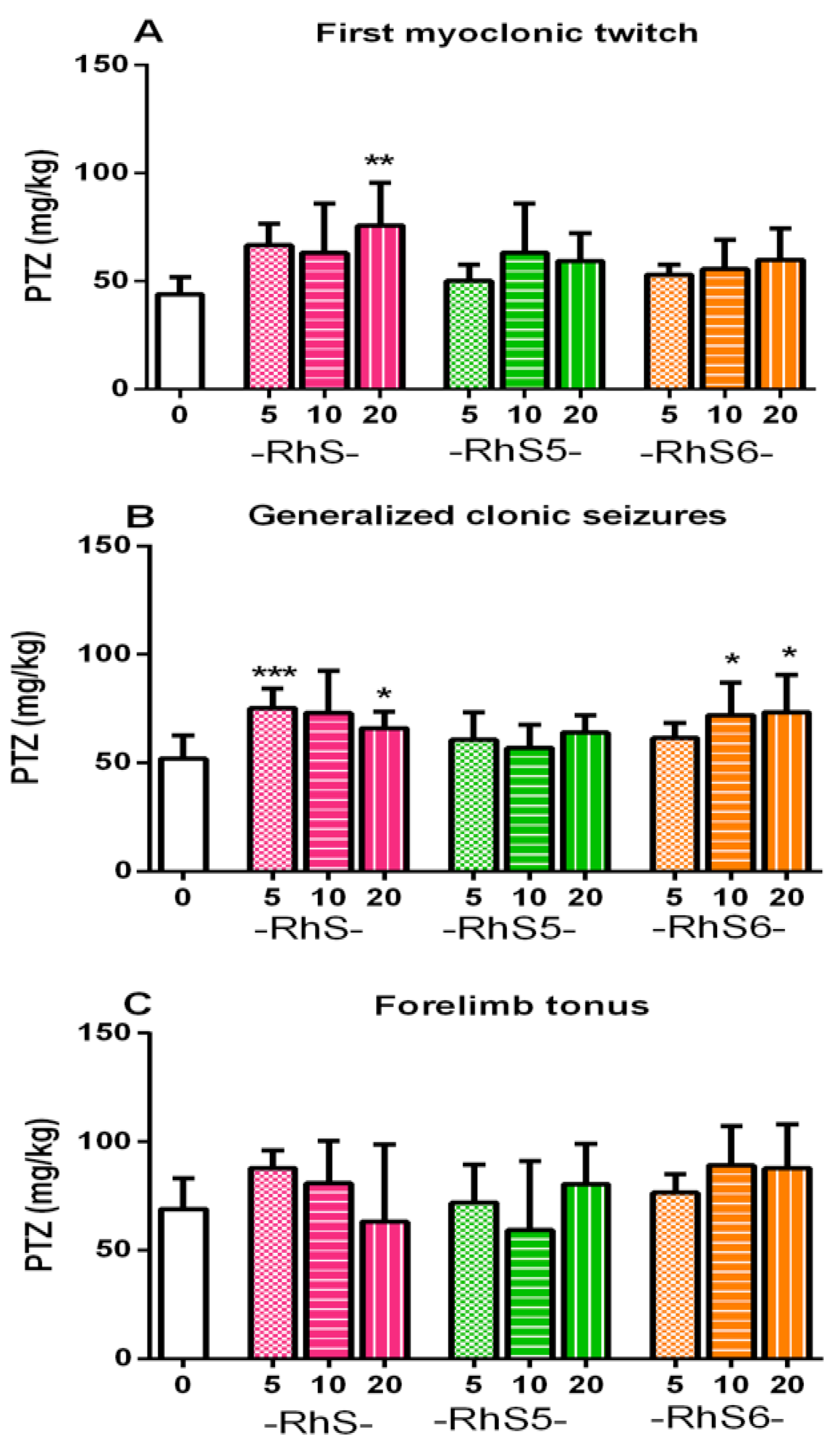
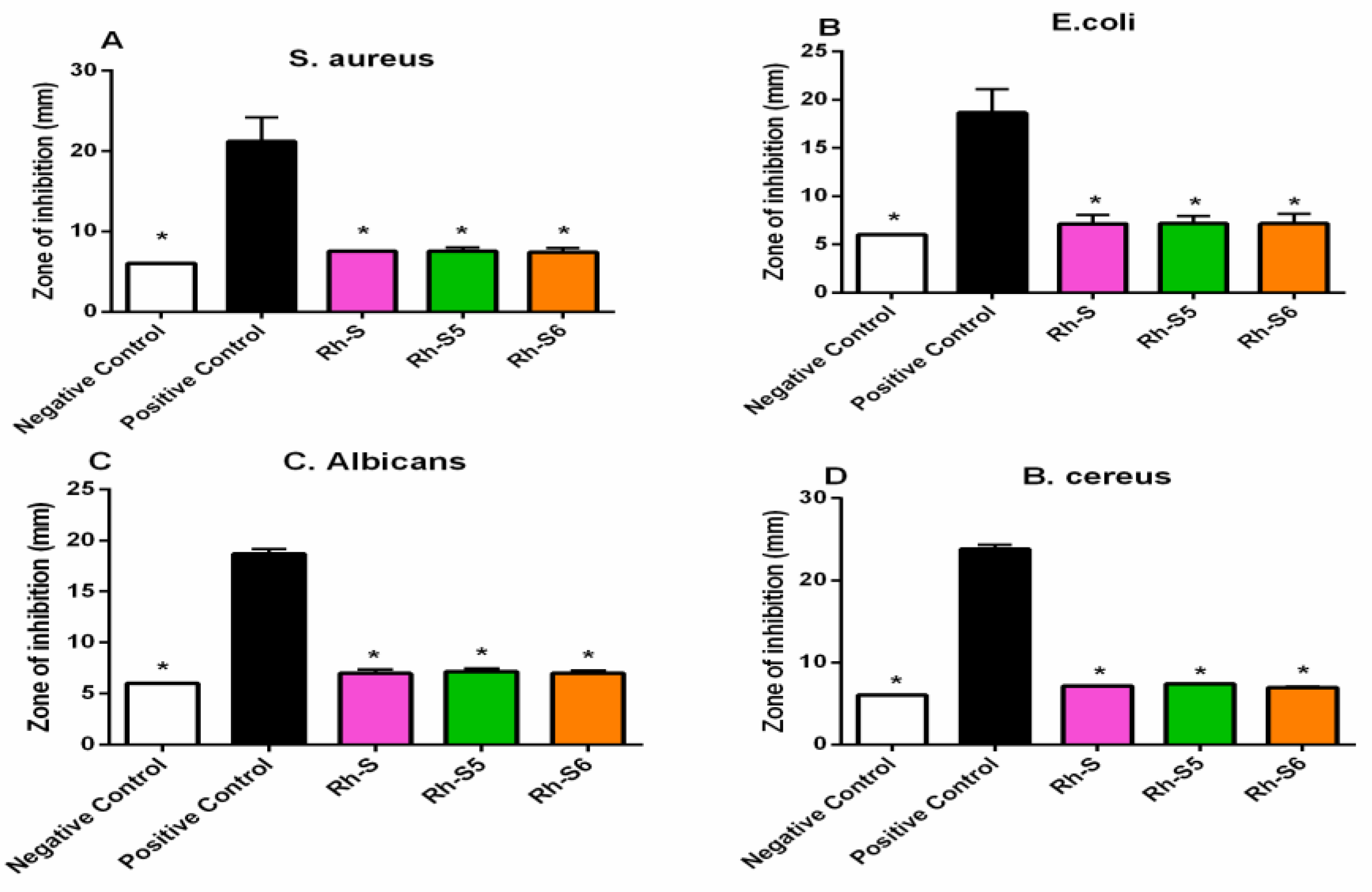
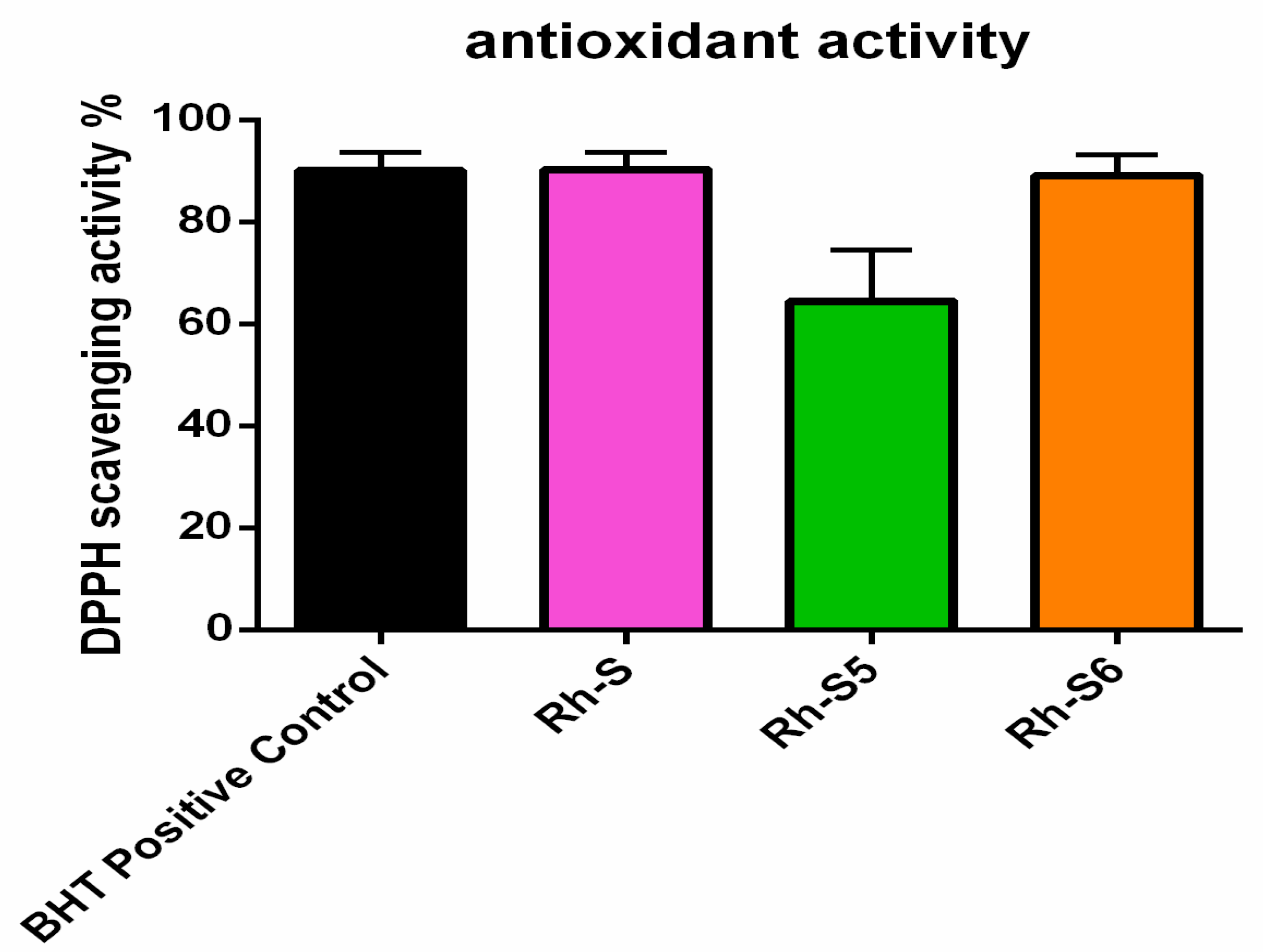
| Code | Molecular Formula | a [MH]+ calculated | a [MH]+ observed | b tR, min | LogP | pKa1 | pKa2 | pI |
|---|---|---|---|---|---|---|---|---|
| Rh-S | C73H95N11O11 | 1301,7213 | 1302,7199 | 41.34 | 0.54 | 7.09 | 4.56 | 5.82 |
| Rh-S5 | C74H97N11O11 | 1315,7369 | 1316,7357 | 43.21 | −0.168 | 5.11 | 5.36 | 5.23 |
| Rh-S6 | C75H99N11O11 | 1329,7526 | 1330,7515 | 44.05 | −0.197 | 6.35 | 4.94 | 5.65 |
| Compounds | ε, [L/(mol.cm)] at 275 nm | ε, [L/(mol.cm)] at 557 nm | λem [nm] at λex = 275 nm | λem [nm] at λex = 560 nm | Stokes shift [cm−1] against λabs = 557 nm |
|---|---|---|---|---|---|
| Rh-S | 3.73 × 106 | 2.14 × 106 | 356 | 585 | 859 |
| Rh-S5 | 6.19 × 106 | 2.28 × 106 | 356 | 584 | 860 |
| Rh-S6 | 6.54 × 106 | 3.22 × 106 | 356 | 585 | 859 |
| Compounds | EPc, V | EPa, V | −Ipc, A | Ipa, A | ΔEpc = Epc − Ep1/2, mV | Nature of the Reduction Process |
|---|---|---|---|---|---|---|
| Rh-S | Epc1 = −0.995 EpC2 = −1.572 | Epa2 = −1.567 | 2.13 × 10−7 1.85 × 10−6 | 1.85 × 10−7 | 5 | QR * |
| Rh-S5 | Epc1 = −1.00 EpC2 = −1.575 | Epa2 = −1.570 | 2.26 × 10−7 1.97 × 10−6 | 1.85 × 10−7 | 5 | QR |
| Rh-S6 | Epc1 = −1.05 EpC2 = −1.595 | Epa2 = −1.586 | 2.72 × 10−7 2.18 × 10−6 | 1.73 × 10−7 | 9 | QR |
| Compound | Regression Equation of ipc, A = f(C, mol L−1) | kosh × 10−6 cm s−1 | D × 10−3 cm2 s−1 |
|---|---|---|---|
| Rh-S | Ip = 2.50 × 10−8+ 0.0348(±0.0023) × C, R2 = 0.991 | 6.01 | 3.23 |
| Rh-S5 | Ip = 8.03 × 10−8+ 0.0511(±0.0010) × C, R2 = 0.998 | 8.82 | 4.28 |
| Rh-S5 | Ip = 8.67 × 10−8+ 0.0533(±0.0022) × C, R2 = 0.995 | 9.21 | 4.34 |
| Group | Dose µg/10 µL | No. of Animals Protected⁄No. of Animals Tested | % Protection |
|---|---|---|---|
| control | 0 | 0/8 | 0 |
| Rh-S | 5 | 4/6 | 67 * |
| 10 | 6/6 | 100 * | |
| 20 | 4/6 | 67 * | |
| Rh-S5 | 5 | 1/6 | 17 |
| 10 | 2/6 | 33 | |
| 20 | 5/6 | 83 * | |
| Rh-S6 | 5 | 2/6 | 33 |
| 10 | 3/6 | 50 | |
| 20 | 4/6 | 67 * |
| Group | Dose µg/10 µL | No. of Animals Protected/No. of Animals Tested | % Protection | % Mortality |
|---|---|---|---|---|
| Control | 0 | 0/6 | 0 | 67 |
| Rh-S | 5 | 3/6 | 50 | 50 |
| 10 | 3/6 | 50 | 0 | |
| 20 | 4/6 | 67 * | 33 | |
| Rh-S5 | 5 | 5/6 | 41 | 17 |
| 10 | 5/12 | 42 | 17 | |
| 20 | 4/6 | 67 * | 17 | |
| Rh-S6 | 5 | 6/6 | 100 * | 0 |
| 10 | 6/6 | 100 * | 0 | |
| 20 | 6/6 | 100 * | 0 |
Publisher’s Note: MDPI stays neutral with regard to jurisdictional claims in published maps and institutional affiliations. |
© 2022 by the authors. Licensee MDPI, Basel, Switzerland. This article is an open access article distributed under the terms and conditions of the Creative Commons Attribution (CC BY) license (https://creativecommons.org/licenses/by/4.0/).
Share and Cite
Todorov, P.; Georgieva, S.; Tchekalarova, J.; Subaer, S.; Peneva, P.; Hartati, H. Synthesis, Characterization and Biological Investigation of New N-Modified Spinorphin Analogs. Pharmaceuticals 2022, 15, 1251. https://doi.org/10.3390/ph15101251
Todorov P, Georgieva S, Tchekalarova J, Subaer S, Peneva P, Hartati H. Synthesis, Characterization and Biological Investigation of New N-Modified Spinorphin Analogs. Pharmaceuticals. 2022; 15(10):1251. https://doi.org/10.3390/ph15101251
Chicago/Turabian StyleTodorov, Petar, Stela Georgieva, Jana Tchekalarova, Subaer Subaer, Petia Peneva, and Hartati Hartati. 2022. "Synthesis, Characterization and Biological Investigation of New N-Modified Spinorphin Analogs" Pharmaceuticals 15, no. 10: 1251. https://doi.org/10.3390/ph15101251
APA StyleTodorov, P., Georgieva, S., Tchekalarova, J., Subaer, S., Peneva, P., & Hartati, H. (2022). Synthesis, Characterization and Biological Investigation of New N-Modified Spinorphin Analogs. Pharmaceuticals, 15(10), 1251. https://doi.org/10.3390/ph15101251









